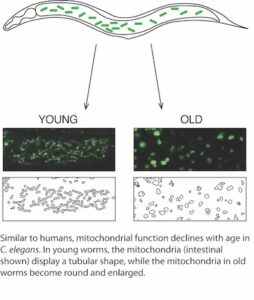Suzanne Angeli, Ph.D.
 Assistant Professor of Molecular & Cellular Biology
Assistant Professor of Molecular & Cellular Biology
Education:
B.S. (2003) Tulane University
Ph.D. (2010) University of California, San Francisco
Postdoctoral training: Buck Institute for Research on Aging
Research Interests:
What do disparate diseases such as cardiovascular disease, Alzheimer’s disease, and cancer have in common? Aging is the number one risk factor for all these disorders, which means that the likelihood of developing an age-related disease increases simply due to your age. Several cell and molecular changes occur with the aging process that increase susceptibility to disease, such as increased protein misfolding, a decline in mitochondrial function, and increased genomic instability. For example, we have clearly observed that COVID-19 disproportionately increases mortality in people over the age of 65, likely due to age-related changes in the immune system. My lab uses the microscopic nematode Caenorhabditis elegans to study the basic biological processes of aging. It was first demonstrated in C. elegans that genes can directly influence how long an organism lives and it was the first organism to have its genome completely sequenced. The nematode is also completely transparent, allowing the use of fluorescent probes to study cellular changes in vivo.
General lab interests include:
- Understanding the relationship between the mitochondrial unfolded protein response (UPRmt) and aging.
- Understanding how signals from the germline affects aging in other tissues.
- Understanding how pathogens can impact cellular processes related to aging, such as protein misfolding and mitochondrial dysfunction.
Publications:
Angeli S*, Foulger AC, Chamoli M , Peiris TH, Gerencser AA, , Shahmirzadi Asadi A, Andersen JK, Lithgow GJ. (2021) The mitochondrial permeability transition pore activates the mitochondrial unfolded protein response and promotes aging. eLife 2021; 10:e63453. PMCID:PMC8410078 *corresponding author
Xie X, Chamoli C, Bhaumik D, Sivapatham R, Angeli S, Andersen JK, Lithgow GJ, Birgit S. (2020) Quantification of Insoluble Protein Aggregation in Caenorhabditis elegans during Aging with a Novel Data-Independent Acquisition Workflow. JoVE, 7 Aug (162). PMCID:PMC7519758
Lucanic M, Plummer WT, Chen E, Harke J, Foulger AC, Onken B, Coleman-Hulbert AL, Dumas KJ, Guo S, Johnson E, Bhaumik D, Xue J, Crist AB, Presley MP, Harinath G, Sedore CA, Chamoli M, Kamat S, Chen MK, Angeli S, Chang C, Willis JH, Edgar D, Royal MA, Chao EA, Patel S, Garrett T, Ibanez-Ventoso C, Hope J, Kish JL, Guo M, Lithgow GJ, Driscoll M, Phillips PC. (2017). Impact of Genetic Background and Experimental Reproducibility on Identifying Chemical Compounds with Robust Longevity Effects. Nature Communications, Vol. 8, 14256. PMCID: PMC5321775.
Leonoudakis D, Rane A, Angeli S, Lithgow GJ, Andersen JK and Chinta S. (2017). Anti-inflammatory and neuroprotective role of natural product securinine in activated glial cells. Implications for Parkinson’s disease. Mediators of Inflammation – Vol. 2017, pg. 11. PMCID: PMC5394397.
Angeli S, Barhydt T, Jacobs R, Killilea DW, Lithgow GJ, and Andersen JK. (2014). Manganese Disturbs Protein and Metal Homeostasis in Caenorhabditis elegans. Metallomics, Issue 10. PMCID: PMC4309368.
Angeli S, Klang I, Sivapatham R, Mark K, Zucker D, Bhaumik D, Lithgow GJ, Andersen JK. (2013). A DNA synthesis inhibitor is protective against proteotoxic stressors via modulation of fertility pathways in Caenorhabditis elegans. Aging, Vol. 5, No. 10. PMCID: PMC3838778.
Angeli S, Shao J, Diamond MI. (2010). F-actin binding regions on the androgen receptor and huntingtin increase aggregation and alter aggregate characteristics. PLoS ONE, Vol. 5, Issue 2. PMCID: PMC2816219.
For the most up to date publications, please visit PubMed here.
